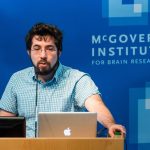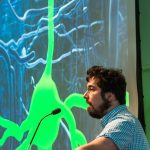Neurons in the mouse cerebellum, expressing the synaptic protein SAPAP-4.
Image: Louis Tee and Guoping Feng
Category: Uncategorized
How the brain controls our habits
Habits are behaviors wired so deeply in our brains that we perform them automatically. This allows you to follow the same route to work every day without thinking about it, liberating your brain to ponder other things, such as what to make for dinner.
However, the brain’s executive command center does not completely relinquish control of habitual behavior. A new study from MIT neuroscientists has found that a small region of the brain’s prefrontal cortex, where most thought and planning occurs, is responsible for moment-by-moment control of which habits are switched on at a given time.
“We’ve always thought – and I still do – that the value of a habit is you don’t have to think about it. It frees up your brain to do other things,” says Institute Professor Ann Graybiel, a member of the McGovern Institute for Brain Research at MIT. “However, it doesn’t free up all of it. There’s some piece of your cortex that are still devoted to that control.”
The new study offers hope for those trying to kick bad habits, says Graybiel, senior author of the new study, which appears this week in the Proceedings of the National Academy of Sciences. It shows that though habits may be deeply ingrained, the brain’s planning centers can shut them off. It also raises the possibility of intervening in that brain region to treat people who suffer from disorders involving overly habitual behavior, such as obsessive-compulsive disorder.
Lead author of the paper is Kyle Smith, a McGovern Institute research scientist. Other authors are recent MIT graduate Arti Virkud and Karl Deisseroth, a professor of psychiatry and behavioral sciences at Stanford University.
Old habits die hard
Habits often become so ingrained that we keep doing them even though we’re no longer benefiting from them. The MIT team experimentally simulated this situation with rats trained to run a T-shaped maze. As the rats approached the decision point, they heard a tone indicating whether they should turn left or right. When they chose correctly, they received a reward – chocolate milk (for turning left) or sugar water (for turning right).
To show that the behavior was habitual, the researchers eventually stopped giving the trained rats any rewards, and found that they continued running the maze correctly. The researchers then went a step further, offering the rats chocolate milk in their cages but mixing it with lithium chloride, which causes light nausea. The rats still continued to run left when cued to do so, although they stopped drinking the chocolate milk.
Once they had shown that the habit was fully ingrained, the researchers wanted to see if they could break it by interfering with a part of the prefrontal cortex known as the infralimbic (IL) cortex. Although the neural pathways that encode habitual behavior appear to be located in deep brain structures known as the basal ganglia, it has been shown that the IL cortex is also necessary for such behaviors to develop.
Using optogenetics, a technique that allows researchers to inhibit specific cells with light, the researchers turned off IL cortex activity for several seconds as the rats approached the point in the maze where they had to decide which way to turn.
Almost instantly, the rats dropped the habit of running to the left (the side with the now-distasteful reward). This suggests that turning off the IL cortex switches the rats’ brains from an “automatic, reflexive mode to a mode that’s more cognitive or engaged in the goal of processing what exactly it is that they’re running for,” Smith says.
Once broken of the habit of running left, the rats soon formed a new habit, running to the right side every time, even when cued to run left. The researchers showed that they could break this new habit by once again inhibiting the IL cortex with light. To their surprise, they found that these rats immediately regained their original habit of running left when cued to do so.
“This habit was never really forgotten,” Smith says. “It’s lurking there somewhere, and we’ve unmasked it by turning off the new one that had been overwritten.”
Online control
The findings suggest that the IL cortex is responsible for determining, moment-by-moment, which habitual behaviors will be expressed. “To us, what’s really stunning is that habit representation still must be totally intact and retrievable in an instant, and there’s an online monitoring system controlling that,” Graybiel says.
The study also raises interesting ideas concerning how automatic habitual behaviors really are, says Jane Taylor, a professor of psychiatry and psychology at Yale University. “We’ve always thought of habits as being inflexible, but this suggests you can have flexible habits, in some sense,” says Taylor, who was not part of the research team.
It also appears that the IL cortex favors new habits over old ones, consistent with previous studies showing that when habits are broken they are not forgotten, but replaced with new ones.
Although it would be too invasive to use optogenetic interventions to break habits in humans, Graybiel says it is possible the technology will evolve to the point where it might be a feasible option for treating disorders involving overly repetitive or addictive behavior.
In follow-up studies, the researchers are trying to pinpoint exactly when during a maze run the IL cortex selects the appropriate habit. They are also planning to specifically inhibit different cell types within the IL cortex, to see which ones are most involved in habit control.
The research was funded by the National Institutes of Health, the Stanley H. and Sheila G. Sydney Fund, R. Pourian and Julia Madadi, the Defense Advanced Research Projects Agency, and the Gatsby Foundation.
AF Harvey Prize Lecture
The prize recognizes outstanding contributions to research in the field of medical engineering. Boyden was awarded the prize for his pioneering research contributions to the field of optogenetics, in which neurons are genetically modified to respond to light. He presented his prize lecture at the McGovern Institute on October 22, 2012.
Calcium reveals connections between neurons
A team led by MIT neuroscientists has developed a way to monitor how brain cells coordinate with each other to control specific behaviors, such as initiating movement or detecting an odor.
The researchers’ new imaging technique, based on the detection of calcium ions in neurons, could help them map the brain circuits that perform such functions. It could also provide new insights into the origins of autism, obsessive-compulsive disorder and other psychiatric diseases, says Guoping Feng, senior author of a paper appearing in the Oct. 18 issue of the journal Neuron.
“To understand psychiatric disorders we need to study animal models, and to find out what’s happening in the brain when the animal is behaving abnormally,†says Feng, the James W. and Patricia Poitras Professor of Neuroscience and a member of the McGovern Institute for Brain Research at MIT. “This is a very powerful tool that will really help us understand animal models of these diseases and study how the brain functions normally and in a diseased state.â€
The lead author of the Neuron paper is McGovern Institute postdoc Qian Chen.
Performing any kind of brain function requires many neurons in different parts of the brain to communicate with each other. They achieve this communication by sending electrical signals, triggering an influx of calcium ions into active cells. Using dyes that bind to calcium, researchers have imaged neural activity in neurons. However, the brain contains thousands of cell types, each with distinct functions, and the dye is taken up nonselectively by all cells, making it impossible to pinpoint calcium in specific cell types with this approach.
To overcome this, the MIT-led team created a calcium-imaging system that can be targeted to specific cell types, using a type of green fluorescent protein (GFP). Junichi Nakai of Saitama University in Japan first developed a GFP that is activated when it binds to calcium, and one of the Neuron paper authors, Loren Looger of the Howard Hughes Medical Institute, modified the protein so its signal is strong enough to use in living animals.
The MIT researchers then genetically engineered mice to express this protein in a type of neuron known as pyramidal cells, by pairing the gene with a regulatory DNA sequence that is only active in those cells. Using two-photon microscopy to image the cells at high speed and high resolution, the researchers can identify pyramidal cells that are active when the brain is performing a specific task or responding to a certain stimulus.
In this study, the team was able to pinpoint cells in the somatosensory cortex that are activated when a mouse’s whiskers are touched, and olfactory cells that respond to certain aromas.
This system could be used to study brain activity during many types of behavior, including long-term phenomena such as learning, says Matt Wachowiak, an associate professor of physiology at the University of Utah. “These mouse lines should be really useful to many different research groups who want to measure activity in different parts of the brain,†says Wachowiak, who was not involved in this research.
The researchers are now developing mice that express the calcium-sensitive proteins and also exhibit symptoms of autistic behavior and obsessive-compulsive disorder. Using these mice, the researchers plan to look for neuron firing patterns that differ from those of normal mice. This could help identify exactly what goes wrong at the cellular level, offering mechanistic insights into those diseases.
“Right now, we only know that defects in neuron-neuron communications play a key role in psychiatric disorders. We do not know the exact nature of the defects and the specific cell types involved,†Feng says. “If we knew what cell types are abnormal, we could find ways to correct abnormal firing patterns.â€
The researchers also plan to combine their imaging technology with optogenetics, which enables them to use light to turn specific classes of neurons on or off. By activating specific cells and then observing the response in target cells, they will be able to precisely map brain circuits.
The research was funded by the Poitras Center for Affective Disorders Research, the National Institutes of Health and the McNair Foundation
Brain’s language center has multiple roles
A century and a half ago, French physician Pierre Paul Broca found that patients with damage to part of the brain’s frontal lobe were unable to speak more than a few words. Later dubbed Broca’s area, this region is believed to be critical for speech production and some aspects of language comprehension.
However, in recent years neuroscientists have observed activity in Broca’s area when people perform cognitive tasks that have nothing to do with language, such as solving math problems or holding information in working memory. Those findings have stimulated debate over whether Broca’s area is specific to language or plays a more general role in cognition.
A new study from MIT may help resolve this longstanding question. The researchers, led by Nancy Kanwisher, the Walter A. Rosenblith Professor of Cognitive Neuroscience, found that Broca’s area actually consists of two distinct subunits. One of these focuses selectively on language processing, while the other is part of a brainwide network that appears to act as a central processing unit for general cognitive functions.
“I think we’ve shown pretty convincingly that there are two distinct bits that we should not be treating as a single region, and perhaps we shouldn’t even be talking about “Broca’s area” because it’s not a functional unit,” says Evelina Fedorenko, a research scientist in Kanwisher’s lab and lead author of the new study, which recently appeared in the journal Current Biology.
Kanwisher and Fedorenko are members of MIT’s Department of Brain and Cognitive Sciences and the McGovern Institute for Brain Research. John Duncan, a professor of neuroscience at the Cognition and Brain Sciences Unit of the Medical Research Council in the United Kingdom, is also an author of the paper.
A general role
Broca’s area is located in the left inferior frontal cortex, above and behind the left eye. For this study, the researchers set out to pinpoint the functions of distinct sections of Broca’s area by scanning subjects with functional magnetic resonance imaging (fMRI) as they performed a variety of cognitive tasks.
To locate language-selective areas, the researchers asked subjects to read either meaningful sentences or sequences of nonwords. A subset of Broca’s area lit up much more when the subjects processed meaningful sentences than when they had to interpret nonwords.
The researchers then measured brain activity as the subjects performed easy and difficult versions of general cognitive tasks, such as doing a math problem or holding a set of locations in memory. Parts of Broca’s area lit up during the more demanding versions of those tasks. Critically, however, these regions were spatially distinct from the regions involved in the language task.
These data allowed the researchers to map, for each subject, two distinct regions of Broca’s area — one selectively involved in language, the other involved in responding to many demanding cognitive tasks. The general region surrounds the language region, but the exact shapes and locations of the borders between the two vary from person to person.
The general-function region of Broca’s area appears to be part of a larger network sometimes called the multiple demand network, which is active when the brain is tackling a challenging task that requires a great deal of focus. This network is distributed across frontal and parietal lobes in both hemispheres of the brain, and all of its components appear to communicate with one another. The language-selective section of Broca’s area also appears to be part of a larger network devoted to language processing, spread throughout the brain’s left hemisphere.
Mapping functions
The findings provide evidence that Broca’s area should not be considered to have uniform functionality, says Peter Hagoort, a professor of cognitive neuroscience at Radboud University Nijmegen in the Netherlands. Hagoort, who was not involved in this study, adds that more work is needed to determine whether the language-selective areas might also be involved in any other aspects of cognitive function. “For instance, the language-selective region might play a role in the perception of music, which was not tested in the current study,” he says.
The researchers are now trying to determine how the components of the language network and the multiple demand network communicate internally, and how the two networks communicate with each other. They also hope to further investigate the functions of the two components of Broca’s area.
“In future studies, we should examine those subregions separately and try to characterize them in terms of their contribution to various language processes and other cognitive processes,” Fedorenko says.
The team is also working with scientists at Massachusetts General Hospital to study patients with a form of neurodegeneration that gradually causes loss of the ability to speak and understand language. This disorder, known as primary progressive aphasia, appears to selectively target the language-selective network, including the language component of Broca’s area.
The research was funded by the Eunice Kennedy Shriver National Institute of Child Health and Human Development, the Ellison Medical Foundation and the U.K. Medical Research Council.
Brain Scan Cover Image: Spring 2012
To win at cards, players must understand the beliefs and intentions of their opponents, an ability known as “Theory of Mind.” Rebecca Saxe studies the brain mechanisms that underlie this quintessentially human ability.
The Changing Human Brain
Mehrdad Jazayeri to join McGovern Institute faculty
We are pleased to announce the appointment of Mehrdad Jazayeri as an Investigator at the McGovern Institute for Brain Research. He will join the institute in January 2013, with a faculty appointment as assistant professor in MIT’s Department of Brain and Cognitive Sciences.
Complex behaviors rely on a combination of sensory evidence, prior experience and knowledge about potential costs and benefits. Jazayeri’s research is focused on the neural mechanisms that enable the brain to integrate these internal and external cues and to produce flexible goal-directed behavior.
In his dissertation work with J. Anthony Movshon at New York University, Jazayeri asked how the brain uses unreliable sensory signals to make probabilistic inferences. His work led to a simple computational scheme that explained how information in visual cortical maps is used for a variety of visual perceptual tasks. Later, as a Helen Hay Whitney postdoctoral fellow, he began to investigate the role of prior experience on perception. Working in the laboratory of Michael Shadlen at the University of Washington, he used a simple timing task to show that humans exploit their prior experience of temporal regularities to make better estimates of time intervals. Using a rigorous mathematical framework — Bayesian estimation — this work provided a detailed model for quantifying how measurements, prior expectations and internal goals influence timing behavior.
Jazayeri then turned to monkey electrophysiology to study how neurons process timing information and how they combine sensory cues with prior experience. For this work, he taught monkeys to reproduce time intervals, as if keeping the beat in music. The animals were provided with beats 1 and 2 and were rewarded for producing a third beat at the correct time. By recording from sensorimotor neurons in the parietal cortex during this task, Jazayeri showed that the pattern of activity is very different during the measurement and production phases of the task, even though the interval is the same. Moreover, he found that the response dynamics of parietal neurons were shaped not only by the immediate time cues but also by the intervals monkeys had encountered in preceding trials.
Building on his previous work, Jazayeri will pursue two long-term research themes at MIT. One line of research will examine how brain circuits measure and produce time, an ability that is crucial for mental capacities such as learning causes and effects, “intuitive physics,” and sequencing thoughts and actions. The other line of research will exploit timing tasks to understand the neural basis of sensorimotor integration, a key component of cognitive functions such as deliberation and probabilistic reasoning.
Understanding complex behaviors such as flexible timing or sensorimotor integration requires methods for manipulating the activity of specific structures and circuits within the brain. Optogenetics, the ability to control brain activity using light, has emerged as a powerful tool for such studies. In a recent collaboration with Greg Horwitz at the Univeristy of Washington, Jazayeri reported the first successful application of optogenetics to evoke a behavioral response in primates. Motivated by this proof-of-principle experiment, Jazayeri plans to combine the traditional tools of psychophysics and electrophysiology with optogenetic manipulations to characterize the circuits that control timing and sensorimotor integration in the primate brain.
Originally from Iran, Jazayeri obtained his B.Sc in Electrical Engineering from Sharif University of Technology in Tehran. He received his PhD from New York University, where he studied with J. Anthony Movshon, winning the Dean’s award for the most outstanding dissertation in the university. After graduating, he was awarded a Helen Hay Whitney fellowship to join the laboratory of Michael Shadlen at the University of Washington, where he has been since 2007.
Martha Constantine-Paton wins lifetime achievement award
Constantine-Paton, a leading figure in the field of developmental neuroscience, has been awarded the Society for Neuroscience’s Mika Salpeter Lifetime Achievement Award.
The award recognizes individuals with outstanding career achievements in neuroscience who have also actively promoted the professional advancement of women in neuroscience. Constantine-Paton will be recognized for her achievements during the Society for Neuroscience’s annual meeting this October.
Over the past 30 years, Constantine-Paton has established a reputation as a leading figure in the field of developmental neuroscience. In particular, her pioneering work on NMDA receptor-dependent plasticity laid the groundwork for our current understanding of how the brain becomes correctly wired in response to activity and experience.
She has also mentored many students and postdocs, among them several prominent women scientists, and she is very active in promoting the career development of her junior colleagues.
“Martha’s research contributions have been extremely influential within her field, and her influence has also been felt through her exemplary record of mentoring and service,†says McGovern Institute director Robert Desimone. “Martha’s career indeed represents a lifetime of achievement and I cannot imagine a more deserving recipient for this honor.â€
Predicting how patients respond to therapy
Social anxiety is usually treated with either cognitive behavioral therapy or medications. However, it is currently impossible to predict which treatment will work best for a particular patient. The team of researchers from MIT, Boston University (BU) and Massachusetts General Hospital (MGH) found that the effectiveness of therapy could be predicted by measuring patients’ brain activity as they looked at photos of faces, before the therapy sessions began.
The findings, published this week in the Archives of General Psychiatry, may help doctors more accurately choose treatments for social anxiety disorder, which is estimated to affect around 15 million people in the United States.
“Our vision is that some of these measures might direct individuals to treatments that are more likely to work for them,” says John Gabrieli, the Grover M. Hermann Professor of Brain and Cognitive Sciences at MIT, a member of the McGovern Institute for Brain Research and senior author of the paper.
Lead authors of the paper are MIT postdoc Oliver Doehrmann and Satrajit Ghosh, a research scientist in the McGovern Institute.
Choosing treatments
Sufferers of social anxiety disorder experience intense fear in social situations, interfering with their ability to function in daily life. Cognitive behavioral therapy aims to change the thought and behavior patterns that lead to anxiety. For social anxiety disorder patients, that might include learning to reverse the belief that others are watching or judging them.
The new paper is part of a larger study that MGH and BU recently ran on cognitive behavioral therapy for social anxiety, led by Mark Pollack, director of the Center for Anxiety and Traumatic Stress Disorders at MGH, and Stefan Hofmann, director of the Social Anxiety Program at BU.
“This was a chance to ask if these brain measures, taken before treatment, would be informative in ways above and beyond what physicians can measure now, and determine who would be responsive to this treatment,” Gabrieli says.
Currently doctors might choose a treatment based on factors such as ease of taking pills versus going to therapy, the possibility of drug side effects, or what the patients’ insurance will cover. “From a science perspective there’s very little evidence about which treatment is optimal for a person,” Gabrieli says.
The researchers used functional magnetic resonance imaging (fMRI) to image the brains of patients before and after treatment. There have been many imaging studies showing brain differences between healthy people and patients with neuropsychiatric disorders, but so far imaging has not been established as a way to predict patient response to particular treatments.
Measuring brain activity
In the new study, the researchers measured differences in brain activity as patients looked at images of angry or neutral faces. After 12 weeks of cognitive behavioral therapy, patients’ social anxiety levels were tested. The researchers found that patients who had shown a greater difference in activity in high-level visual processing areas during the face-response task showed the most improvement after therapy.
The findings are an important step towards improving doctors’ ability to choose the right treatment for psychiatric disorders, says Greg Siegle, associate professor of psychiatry at the University of Pittsburgh. “It’s really critical that somebody do this work, and they did it very well,” says Siegle, who was not part of the research team. “It moves the field forward, and brings psychology into more of a rigorous science, using neuroscience to distinguish between clinical cases that at first appear homogeneous.”
Gabrieli says it’s unclear why activity in brain regions involved with visual processing would be a good predictor of treatment outcome. One possibility is that patients who benefited more were those whose brains were already adept at segregating different types of experiences, Gabrieli says.
The researchers are now planning a follow-up study to investigate whether brain scans can predict differences in response between cognitive behavioral therapy and drug treatment.
“Right now, all by itself, we’re just giving somebody encouraging or discouraging news about the likely outcome of therapy,” Gabrieli says. “The really valuable thing would be if it turns out to be differentially sensitive to different treatment choices.”
The research was funded by the Poitras Center for Affective Disorders Research and the National Institute of Mental Health.









